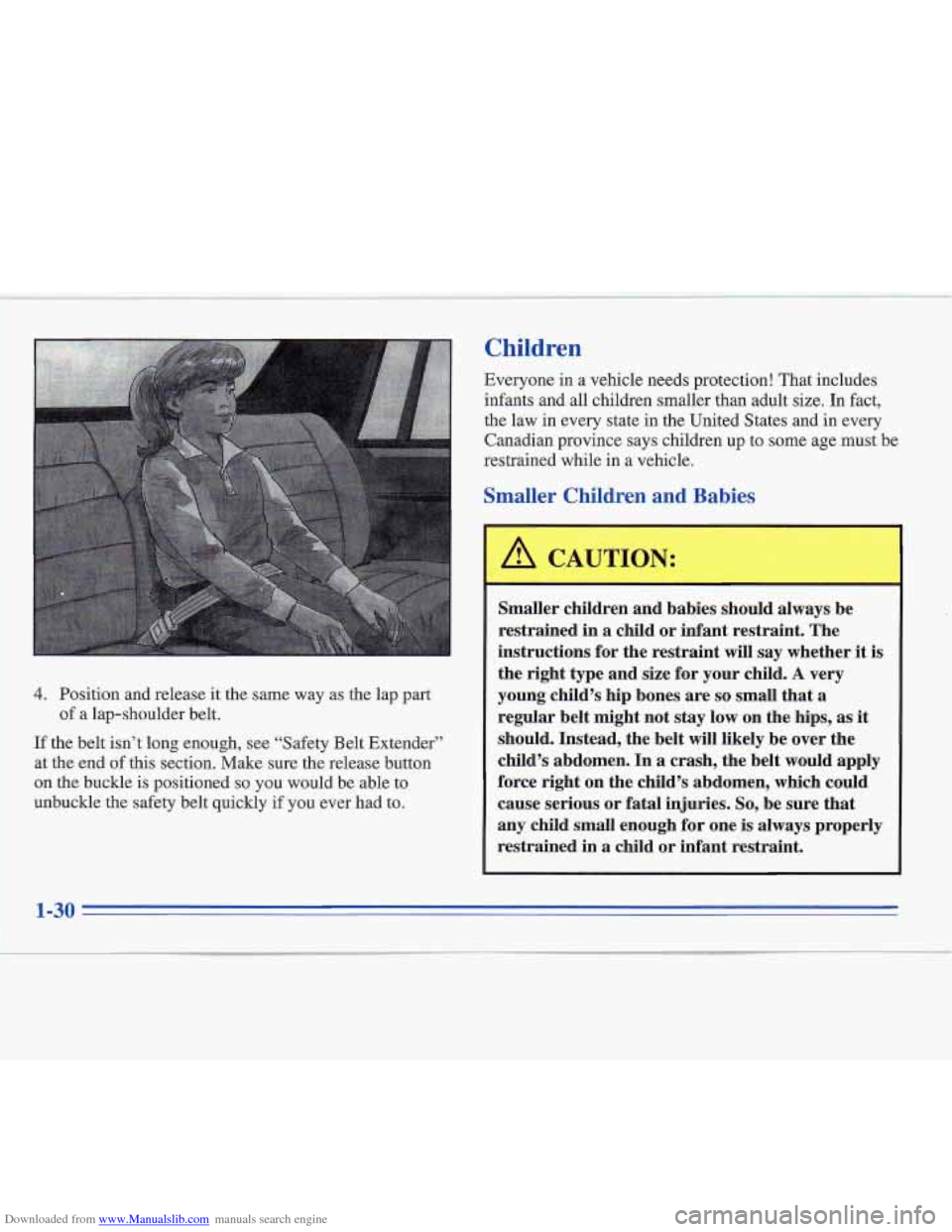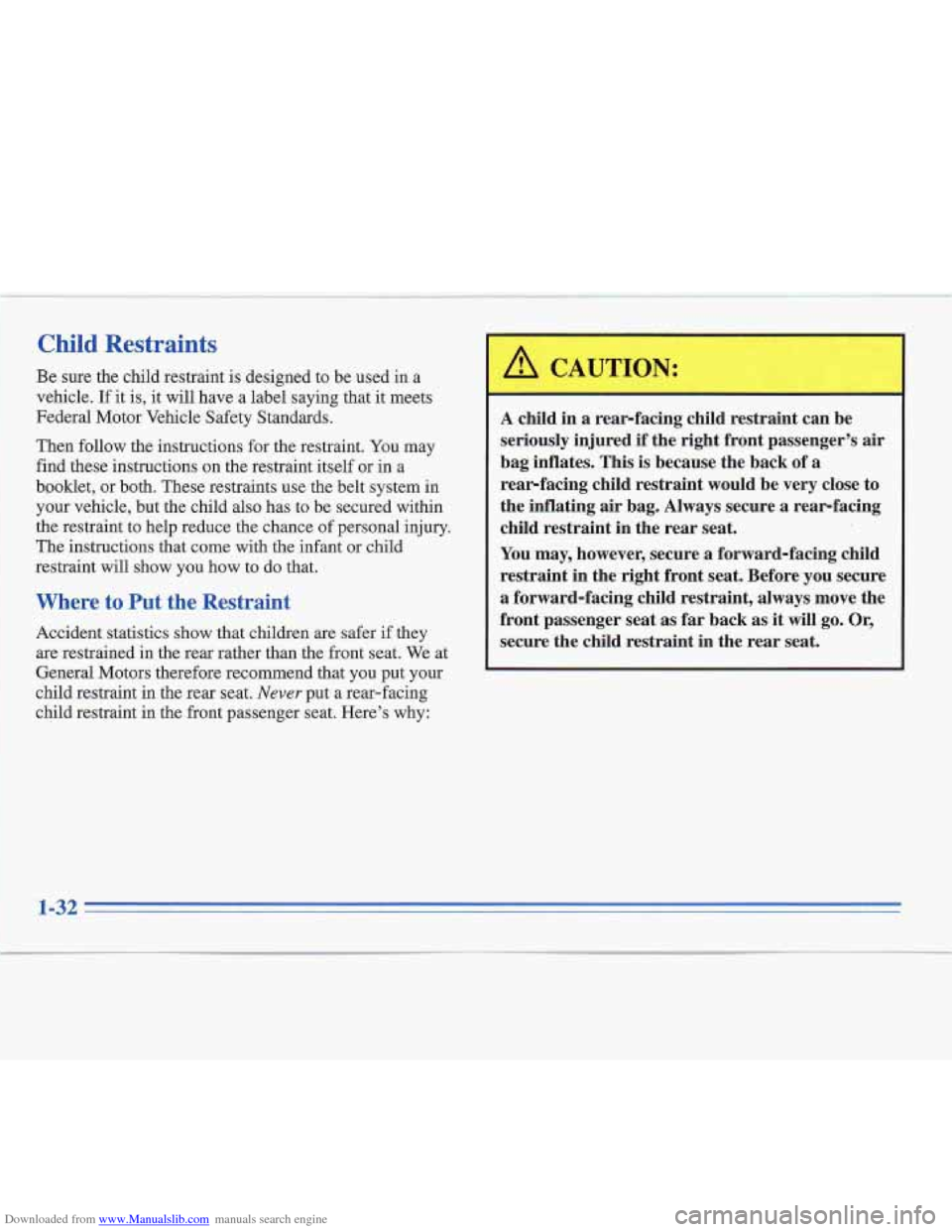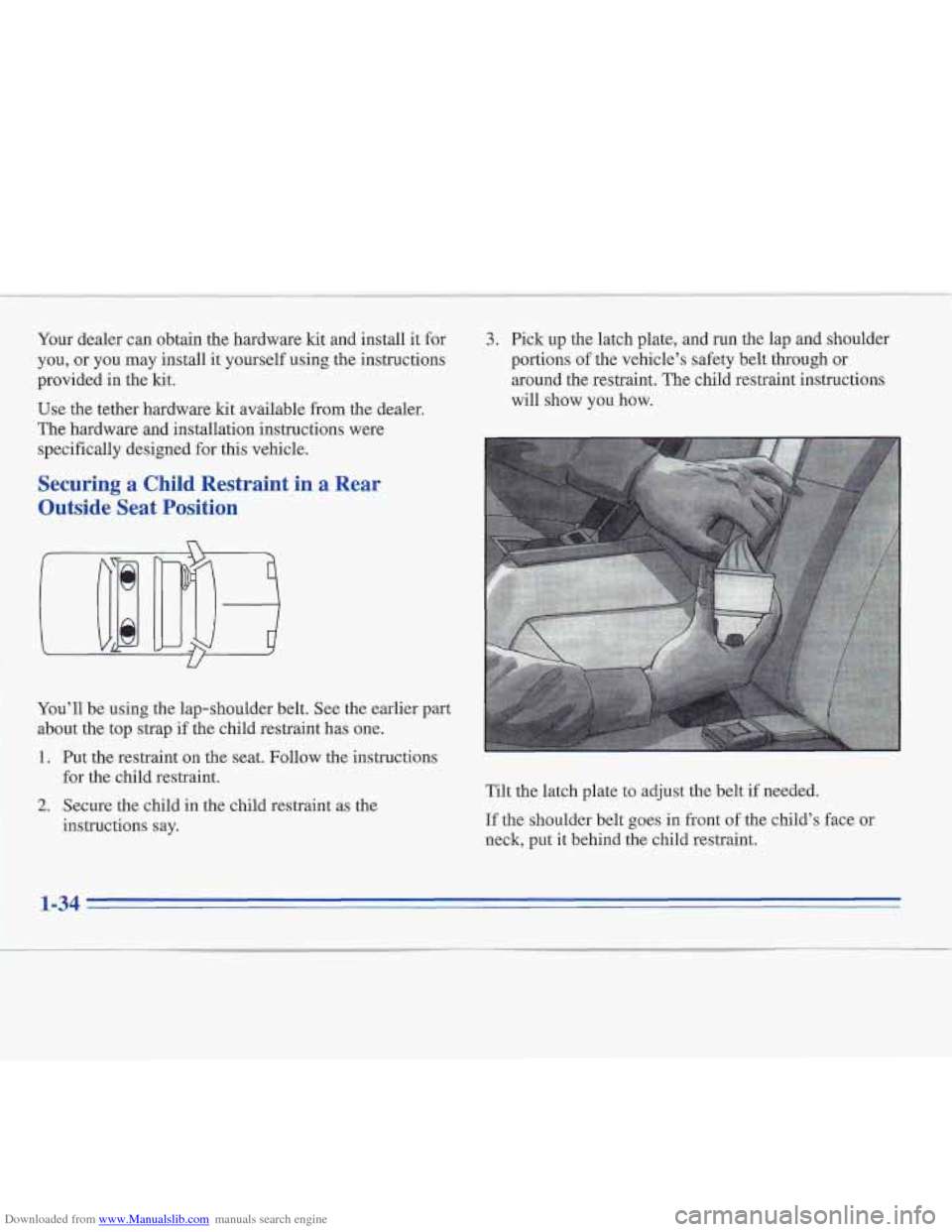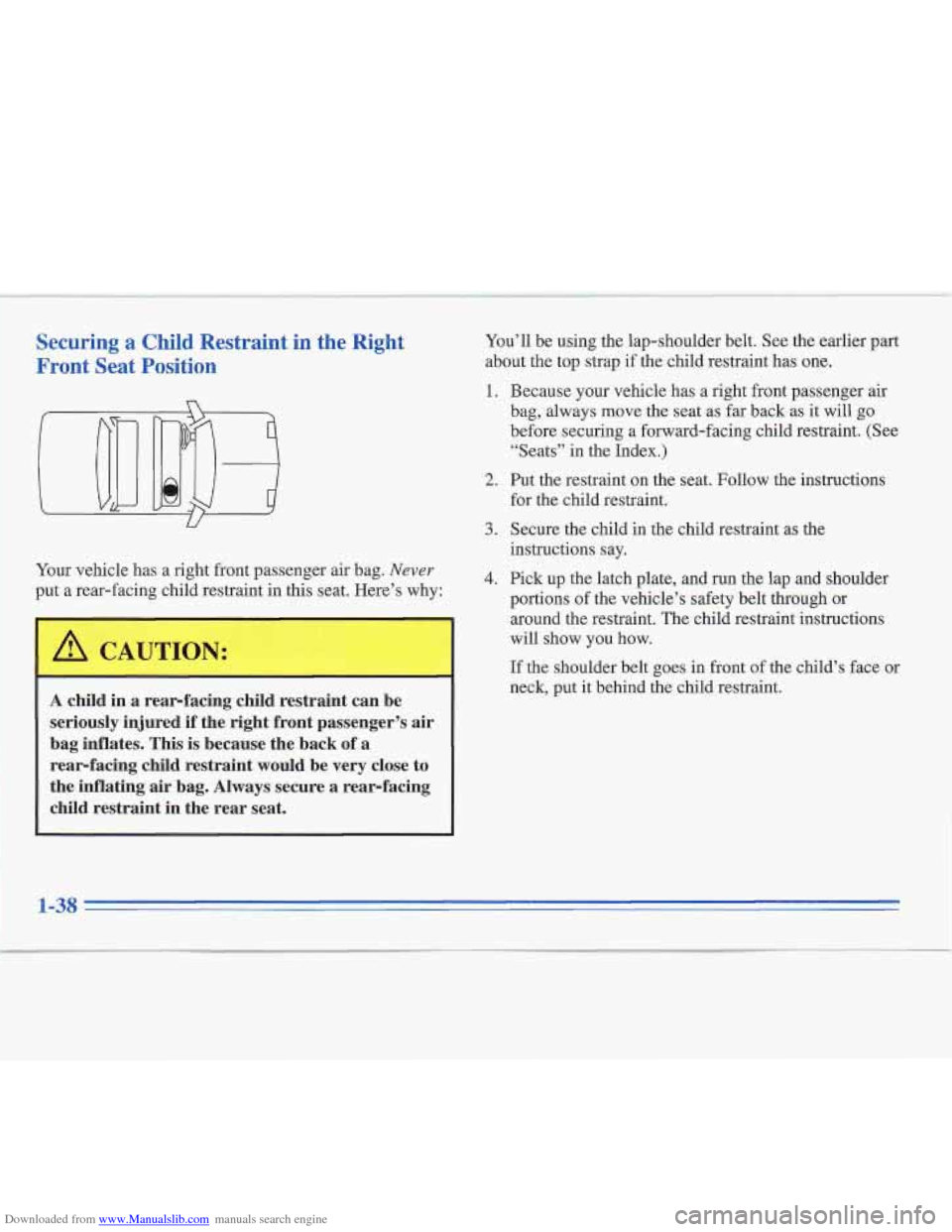Page 45 of 306

Downloaded from www.Manualslib.com manuals search engine 4. Position and release it the same way as the lap part
of a lap-shoulder belt.
If the belt isn’t long enough, see “Safety Belt Extender”
at the end of this section. Make sure the release button
on the buckle is positioned
so you would be able to
unbuckle the safety belt quickly if you ever had to.
Children
Everyone in a vehicle needs protection! That~includes
infants and all children smaller than adult
size. In fact,
the law in every state in the United States and in every
Canadian province says children up to some age
must be
restrained while in a vehicle.
Smaller Children and Babies
A CAUTION:
Smaller children and babies should always be
restrained in a child or infant restraint. The
instructions for the restraint will say whether
it is
the right type and size for your child. A very
young child’s hip bones are so small that a
regular belt might not stay low on the hips, as it
should. Instead, the belt will likely be over the
child’s abdomen. In
a crash, the belt would apply
force right on the child’s abdomen, which could
cause serious or fatal injuries.
So, be sure that
any child small enough for one is always properly
restrained in
a child or infant restraint.
Page 47 of 306

Downloaded from www.Manualslib.com manuals search engine Child Restraints
Be sure the child restraint is designed to be used in a
vehicle. If it is, it will have a label saying that it meets
Federal Motor Vehicle Safety Standards.
Then follow the instructions far the restraint.
You may
find these instructions on the restraint itself or in
a
bQoklet, or both. These restraints use the belt system in
your vehicle, but the child also has to be secured within
the restraint to help reduce the chance
of personal injury.
The instructions that come with the infant or child
restraint will show you how to do that.
‘ Where to Put the Restraint
Accident statistics show that children are safer if they
are restrained in the rear rather than the front seat. We at
General Motors therefore recommend that you put your
child restraint in the rear seat.
Never put a rear-facing
child restraint in the front passenger seat. Here’s why:
A GArnIONr
A child in a rear-facing child restraint can be
seriously injured if the right front passenger’s air
bag inflates.
This is because the back of a
rear-facing child restraint would be very close to
the inflating air bag. Always secure a rear-facing
child restraint in the rear seat.
You may, however, secure a forward-facing child
restraint in the right front seat. Before you secure
a forward-facing child restraint, always move the
front passenger seat as far back as it will go. Or,
secure the child restraint in the rear seat.
a
Page 49 of 306

Downloaded from www.Manualslib.com manuals search engine Your dealer can obtain the hardware ‘kt and install it for
you, or you may install
it yourself using the instructions
provided in the kit.
Use the tether hardware kit available from the dealer.
The hardware and installation instructions were
specifically designed for this vehicle.
Securing a Child Restraint in a Rear
Outside Seat Position
I
You’ll be using the lap-shoulder belt. See the earlier part
about the top strap if the child restraint has one.
1. Put the restraint on the seat. Follow the instructions
for the child restraint.
2. Secure the child in the child restraint as the
instructions say.
3. Pick up the latch plate, and run the lap and shoulder
portions
of the vehicle’s safety belt through or
around the restraint. The child restraint instructions
will show you how.
Tilt the latch plate to adjust the belt if needed.
If the shoulder belt goes in front of the child’s face or
neck, put it behind the child restraint.
1-34
Page 51 of 306
Downloaded from www.Manualslib.com manuals search engine Securing a Chilq Restraint in the Center
Rear Seat Position
You'll be using the lap belt.
A CAUTION:
I-
A child in a child restraint in the center front seat
can be badly injured by the right front passenger
air bag if it inflates. Never secure a child restraint
in the center front seat. It's always
better to
secure a
child restraint in the rear seat. You may,
however, secure a forward-facing child restraint
in the right front passenger seat, but
only with
the seat moved all the way back.
See the earlier part about the top strap if the child
restraint has one.
1. Put the restraint on the seat. Follow the instructions
for the child restraint.
2. Secure the child in the child restraint as the
instructions say.
3. Pull the lap belt all the way out without stopping.
1-36
c
Page 53 of 306

Downloaded from www.Manualslib.com manuals search engine Securing a Child Restraint in the Right
Front Seat Position
Your vehicle has a right front passenger air bag. Never
put a rear-facing child restraint in this seat. Here’s why:
I A CAUTION:
You’ll be using the lap-shoulder belt. See the earlier part
about the top strap if the child restraint has one.
1.
2.
3.
4.
Because your vehicle has a right front passenger air
bag, always move the seat as far back as it will go
before securing a forward-facing child restraint. (See
“Seats” in the Index.)
Put the restraint on the seat. Follow the instructions
for the child restraint.
Secure the child in the child restraint as the
instructions say.
Pick up the latch plate, and run the lap and shoulder
portions of the vehicle’s safety belt through or
around the restraint. The child restraint instructions
will show
you how.
If the shoulder belt goes in front of the child’s face or
neck, put it behind the child restraint.
A
child in a rear-facing child restraint can be
seriously injured if the right front passenger’s air
bag inflates. This
is because the back of a
rear-facing child restraint would be very close
to
the inflating air bag. Always secure a rear-facing
child restraint in the rear seat.
1-38
Page 54 of 306
Downloaded from www.Manualslib.com manuals search engine 5. Buckle the belt. Make sure the release button is
positioned so you would be able to unbuckle the
safety belt quickly if
you ever had to.
6. Pull the rest of the lap belt all the way out of the
retractor to set the lock.
1-39
Page 55 of 306
Downloaded from www.Manualslib.com manuals search engine 8. Push and pull the child restraint in different
To remove the child restraint, just unbuckle the vehicle’s
safety belt and let it go back all the way. The safety belt
will move freely again and be ready to work
for an adult
or larger child passenger.
directions to
be sure it is secure.
7. To tighten the belt, feed the lap belt back into the
retractor while
you push down on the child restraint.
1-40
Page 56 of 306
Downloaded from www.Manualslib.com manuals search engine Larger Children If you have the choice, a child should sit next to a
window
so the child can wear a lap-shoulder belt and
get the additional restraint a shoulder belt can provide.
Accident statistics show that children are safer if they
are restrained in the rear seat. But they need to use the
safety belts properly.
Children who have outgrown child restraints should
wear the vehicle’s safety belts.
0 Children who aren’t buckled up can be thrown out in
a crash.
0 Children who aren’t buckled up can strike other
people who
are.
1-41